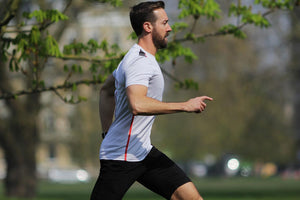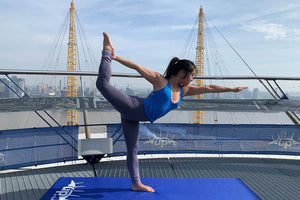With the holiday season fast approaching, how much time should you be lounging on the beach with a piña colada in hand, or should you be stressing about hitting the hotel gym? It's a classic holiday dilemma for many fitness enthusiasts, and we're here to help you navigate it.
Already on your holiday or don't fancy the long read? Click play on our podcast episode below:
Some numbers for you to consider, but don't make your mind up just yet!







Navigating Fitness on Holiday: Your Evidence-Based Guide to Maintaining Gains and Efficient Recovery
The holiday season often throws a spanner in the works for those dedicated to their fitness. That yearning for a proper break and a bit of indulgence frequently clashes with the commitment to a consistent training routine. This report aims to clear up the impact of short breaks on your fitness, giving you solid, evidence-based answers about training while you're away, how much fitness you might lose, and how quickly you can get back in shape. By delving into the nitty-gritty of "detraining" and offering practical tips, this guide hopes to empower you to make informed decisions that support your overall well-being during your well-deserved holidays.
Here are our top 10 evidence-based tips for navigating fitness on holiday:
-
Prioritize Movement, Not Just Structured Workouts: Instead of feeling pressured to replicate your exact gym routine, focus on integrating physical activity into your vacation plans. This could mean exploring a new city on foot, going for a run on the beach, or hiking a scenic trail. Your content notes that "even minimal, consistent effort through integrated activities can significantly contribute to maintaining fitness and well-being."
-
Embrace High-Intensity Interval Training (HIIT): When time is limited, short, intense sessions can be incredibly effective. Your guide suggests that "shorter, more intense sessions like High-Intensity Interval Training (HIIT) (20-30 minutes) can be highly effective when time is limited." This allows for maximum impact in minimal time.
-
Pack Portable Fitness Gear: Don't underestimate the power of compact equipment. "Packing light, portable gear like resistance bands for strength work or a travel yoga mat for bodyweight exercises can facilitate impromptu workouts." This makes it easy to squeeze in a session anywhere, anytime.
-
Integrate "Minimal Effort Strategies" Throughout Your Day: You don't always need a dedicated workout slot. Your content suggests "performing squats while waiting in line, stretching in doorways, taking leisurely walks after dinner, or committing to swimming laps if a pool or beach is accessible." Every bit of movement adds up.
-
Make Fitness Social: Turn your workouts into fun, shared experiences. "Making fitness social by inviting travel companions to join in activities like a morning yoga session, group run, or beach volleyball can make exercise more enjoyable and less of a chore."
-
Set Realistic Expectations (and Embrace Detraining's Minimal Impact): Understand that a short break won't undo all your hard work. Your guide highlights that "a one-week break from training generally results in minimal significant fitness loss, though some rapid physiological shifts do occur at the cellular level." For strength and muscle mass, a "one-week break from training is largely inconsequential."
-
Listen to Your Body and Prioritize Recovery: Holidays are for unwinding. If you're fatigued from travel or sightseeing, it's okay to skip a planned workout. Your report emphasizes that "if fatigued from sightseeing or travel, prioritizing rest and recovery over pushing through a planned workout is a sensible approach." A complete break can even prevent overtraining.
-
Understand "Muscle Memory" for Efficient Comebacks: Don't stress about losing all your gains. "Muscle memory refers to the inherent ability of muscles to 'remember' prior adaptations and movements," allowing for a rapid regain of strength and size. You'll likely bounce back quicker than you think.
-
Factor in Tendon Elasticity for Your Return to Training: When you get back to your routine, be mindful of your connective tissues. Your guide advises, "Gradually increasing weight is vital to allow tendons sufficient time to regain their elasticity. Rushing back to heavy weights while tendons are still stiff significantly increases the risk of tears or other injuries."
-
Embrace the Mental Benefits of a Break: Sometimes, a calculated break is exactly what you need. Your content notes that "short, planned breaks can have significant psychological benefits, combating boredom and renewing motivation... thereby optimizing long-term adherence and enjoyment of fitness." View your holiday as a chance to refresh your mind and body for continued fitness success.
The Holiday Fitness Conundrum: To Train or Not To Train?
Deciding whether to stick to your fitness routine during the holidays involves weighing up the pros and cons. It's a very personal choice, influenced by your individual goals, your holiday plans, and how much you really want to kick back and relax.
Benefits of Exercising on Holiday
Squeezing in some physical activity during your time off offers several perks that go beyond just keeping trim.
-
Looking After Your Physical and Mental Well-being: Exercise is a brilliant natural stress-buster, which is a huge bonus during a time often linked with extra demands like present shopping, travelling, and party planning. Physical activity releases endorphins, known for boosting your mood and helping you feel calm and focused. The Mayo Clinic stresses that pretty much any form of exercise, from aerobics to yoga, can ease stress, thereby building up your emotional and mental resilience. This all adds up to a much more enjoyable and less taxing holiday experience.
Beyond stress reduction, exercise can combat that common holiday sluggishness by giving your energy levels a boost. Harvard Health Publishing explains that physical activity encourages muscle cells to produce more mitochondria, the cellular powerhouses responsible for generating fuel for the body. Regular exercise also improves blood flow and triggers endorphin release, giving you a natural surge of energy. This revitalisation helps you fully enjoy the festivities without feeling utterly knackered.
What's more, consistent exercise can help you enjoy festive treats without feeling overly guilty. By helping you manage your calorie intake, it gives you the flexibility to indulge occasionally without compromising your long-term health and fitness goals. This approach makes it easier to really savour your favourite holiday dishes, reducing that psychological burden often linked with dietary choices during celebratory periods.
-
Keeping Your Routine and Preventing "Detraining": A fundamental part of staying fit is consistency. Holding onto your current fitness level is far easier than trying to get back on track after a long break. Holidays, with their whirlwind of activities, can easily mess with established routines, making it tough to get back into training once you're home. A study published in the Journal of Rehabilitation Medicine highlights that even a two-week break from regular physical activity can lead to significant losses in muscle mass and strength. This really underscores the importance of some consistent activity during holidays to lessen the effects of "detraining" and avoid the struggle of starting from scratch when you return home.
-
Opportunities for "Me Time" and Healthy Family Traditions: In a season often focused on giving to others, carving out dedicated workout times can provide invaluable "me time" for self-care. This commitment to your personal well-being can anchor your routines amidst the holiday rush, preventing a domino effect where other healthy habits might go by the wayside. Plus, exercise can turn into a fun and engaging way to bond with family. Activities like a kickabout, friendly races, skiing, sledging, or ice skating can foster healthy competition and create shared experiences, establishing positive family traditions that go beyond the holiday period.
Considerations for Taking a Break
While the benefits of holiday exercise are clear, there are valid reasons why some might choose to take a complete break.
-
Prioritising Relaxation and Avoiding Overtraining: For many, a holiday is a crucial period for complete relaxation and recharging, especially if daily life is packed with responsibilities. Interrupting this much-needed downtime with structured workouts might take away from the main goal of unwinding. A complete break can also be a clever move to prevent overtraining syndrome, a condition marked by fatigue and underperformance resulting from too much training without enough recovery.
-
Time Constraints and Potential Disruption to Holiday Plans: Holiday schedules are often jam-packed with sightseeing, social gatherings, and other activities, making it genuinely tough to find time for workouts. Trying to squeeze in exercise might feel like an added stress rather than a benefit, potentially eating into valuable time that could be spent exploring your destination or enjoying time with your travel companions.
-
Risk of Overdoing It: Holidays often involve more incidental physical activity, such as extensive walking while exploring or taking part in adventure sports. Adding structured workouts on top of these activities can lead to overexertion, increasing the risk of injury or exhaustion. It's important to remember that your body needs adequate rest to recover from all forms of physical exertion.
Finding Your Balance: Strategies for Holiday Fitness
The key to holiday fitness isn't rigid adherence, but smart adaptation. The aim is to integrate activity in a way that complements, rather than competes with, your holiday experience. This approach acknowledges that successful holiday fitness isn't about replicating your home routine but adapting it to your holiday surroundings. Even minimal, consistent effort through integrated activities can significantly help maintain your fitness and well-being, reducing the perceived "cost" of exercising on holiday.
-
Flexible Movement Plans and Creative Activity Integration: Instead of rigid gym sessions, think about weaving physical activity directly into your holiday plans. This could involve exploring new places by running on the beach, hiking a scenic trail, joining a local yoga class, or hiring a bike to tour a city. Such activities combine fitness with sightseeing, making exercise an enjoyable part of the adventure. Adjusting your workout goals is also crucial; shorter, more intense sessions like High-Intensity Interval Training (HIIT) (20-30 minutes) can be highly effective when time is tight. Most importantly, listening to your body is paramount. If you're feeling knackered from sightseeing or travelling, prioritising rest and recovery over pushing through a planned workout is a sensible approach.
-
Minimal Effort Strategies: Even without dedicated workout sessions, keeping active is achievable. Simple movements can be incorporated throughout the day, such as doing squats while waiting in a queue, stretching in doorways, taking leisurely walks after dinner, or committing to swimming lengths if a pool or beach is accessible. Packing light, portable gear like resistance bands for strength work or a travel yoga mat for bodyweight exercises can make impromptu workouts easier. Make fitness social by inviting travel companions to join in activities like a morning yoga session, group run, or beach volleyball - this can make exercise more enjoyable and less of a chore. Setting reminders can also be helpful in an unfamiliar setting to maintain consistency. This approach leverages the preventative power of consistency; even if the physiological losses from a short break are minimal, the psychological and habitual cost of breaking a routine and having to "start from scratch" can be significant. Maintaining some level of activity supports habit continuity and long-term adherence.
The Science of Detraining: What Happens When You Stop?
When regular training stops, your body goes through a process known as "detraining," which reverses the positive physiological adaptations gained through exercise. Understanding these changes is crucial for managing your fitness expectations during and after holiday breaks.
Understanding Detraining
Detraining is defined as the partial or complete loss of training adaptations that results from a reduction or complete cessation of the training stimulus, often due to illness, injury, or active recovery breaks. Unlike beneficial rest and recovery, detraining represents an extended period of inactivity that leads to a reduction in physical fitness.
When exercise stops, several physiological changes occur. These include a decline in cardiovascular gains, such as the heart's efficiency in pumping blood and the body's ability to use carbohydrates for fuel and process oxygen in the muscles. Improvements in blood pressure, cholesterol levels, and blood sugar may also diminish, and you might experience some weight gain. For those engaged in strength training, gains in muscle size, strength, and endurance will gradually taper off. The extent of fitness loss is influenced by several factors, including the duration of the exercise layoff, age, and your initial fitness level. Notably, highly trained or elite athletes may experience greater reductions in certain parameters compared to recreational or newly trained individuals. This phenomenon, sometimes referred to as the "athlete's paradox" in detraining, occurs because highly trained individuals possess more pronounced physiological adaptations (e.g., larger left ventricular mass, higher VO2 Max), meaning there is a greater magnitude of adaptation to reverse when the training stimulus is removed. Their bodies are highly specialised and thus more sensitive to the removal of that specific stimulus.
Impact of a 1-Week Holiday Break
A one-week break from training generally results in minimal significant fitness loss, though some rapid physiological shifts do occur at the cellular level.
-
Cardiovascular Fitness: One of the earliest and most rapid changes observed is the loss of mitochondrial adaptations. The body begins to lose muscle mitochondrial adaptations within the first week of inactivity. After just one week of detraining, muscle mitochondria losses can be as high as 50% of what was gained in the initial five weeks of exercise. This represents a significant and immediate cellular-level change.
Despite these rapid cellular changes, a full week of detraining typically results in minimal measurable loss in overall cardiovascular fitness for most individuals. Measurable drops in values such as VO2 Max (maximal oxygen uptake), MAP (maximum aerobic power), or FTP (functional threshold power) usually begin after 10 days to two weeks of inactivity. A meta-analysis specifically examining one-week detraining periods found no statistically significant change in VO2 Max or stroke volume in pooled descriptive analysis. However, it is important to note that blood sugar levels can become elevated after as little as three days of inactivity in young, healthy individuals. This indicates a rapid, subtle metabolic shift that can occur even before noticeable performance declines, highlighting that "fitness" encompasses metabolic efficiency beyond just strength or endurance.
-
Strength and Muscle Mass: For strength and muscle mass, a one-week break from training is largely inconsequential. Taking a full week off from the gym doesn't typically lead to any detrimental or significant loss of previous fitness gains. Visible muscle loss is unlikely to occur with training breaks even as long as two weeks. Furthermore, neuromuscular coordination patterns, which are crucial for strength and skill, are maintained fairly well during short periods of detraining, minimising loss from that perspective. Interestingly, some evidence suggests a temporary increase in peak power and muscular strength 7-10 days after detraining, possibly due to recovery from accumulated fatigue.
Impact of a 2-Week Holiday Break
A two-week holiday break begins to show more measurable effects, particularly in cardiovascular fitness, while strength and muscle mass generally remain resilient.
-
Cardiovascular Fitness: A period of 10 days to two weeks represents the maximum duration one can typically take off without experiencing a moderate amount of detraining in cardiovascular fitness. Within this timeframe, a measurable loss of approximately 2-3% in values such as VO2 Max, MAP, or FTP can occur. For endurance-trained male athletes, two weeks of detraining results in significant reductions in VO2max, exercise time to exhaustion (ET), and maximal stroke volume (SVmax). Additionally, maximal heart rate (HRmax) significantly increases, indicating a reduction in cardiovascular efficiency. The volume of circulating blood and blood plasma can decrease by 5-12%, and systolic blood volume by 12-20%. Furthermore, left ventricular mass (LVM), a structural adaptation of the heart that supports greater maximal stroke volume, is reduced following detraining of one week or more, with highly trained athletes experiencing greater reductions. While slight reductions in enzymatic activity for high-intensity efforts (anaerobic capacity) can begin within 3-4 days without training, these changes are typically quickly regained with one or two high-intensity sessions.
-
Strength and Muscle Mass: Similar to a one-week break, visible muscle loss is generally not expected after two weeks of detraining. While overall strength tends to be maintained for longer periods, some studies on endurance athletes have shown a significant decrease in isokinetic knee extensor strength after two weeks of detraining, though knee flexor strength and muscle endurance may remain stable. Body mass can significantly increase after two weeks of detraining, while body fat percentage may remain stable. Some research even suggests that short periods of detraining might enhance anabolic hormonal milieu and increase lean mass in endurance runners. Overall, two weeks of detraining can lead to a significant decline in general physical fitness, affecting cardiovascular endurance, lean muscle mass, and insulin sensitivity. However, more substantial muscle mass reductions are typically documented after four weeks or more of inactivity.
The data clearly illustrates that different fitness components decline at different rates. Cardiovascular fitness, particularly at the cellular level (mitochondrial adaptations) and in terms of blood volume, begins to decline relatively quickly. In contrast, strength and overall muscle mass exhibit greater resilience over short periods. This differential rate of change is critical for tailoring holiday fitness advice; for someone primarily concerned with strength, a two-week break is far less impactful than for an endurance athlete.
The Comeback: Getting Back in Shape After a Full Break
The thought of losing fitness can be daunting, but the human body has a remarkable ability to recover, largely thanks to the phenomenon of muscle memory. This section looks at how long it takes to regain fitness after a complete break and offers strategies for an efficient and safe return to training.
The Power of Muscle Memory
Muscle memory refers to the inherent ability of muscles to "remember" prior adaptations and movements. This allows for a rapid regain of strength and size upon the resumption of training, even after prolonged periods of inactivity. This capability stems from long-term structural changes within muscle tissue and the improved efficiency of neural pathways responsible for movement. These physiological changes persist even when training ceases, providing a foundation for quicker recovery.
A similar effect is observed with cardiovascular exercise. The heart, lungs, and mitochondria, which adapt to regular aerobic training, retain a degree of their enhanced efficiency. This means that upon retraining, the body can recover its previous cardiovascular capacity more quickly than it took to build it initially. This inherent biological advantage allows individuals to bounce back to their previous fitness levels often in a fraction of the time it took to achieve them.
Time to Regain Cardiovascular Fitness
The time required to regain cardiovascular fitness after a break varies depending on the duration of inactivity and individual factors.
-
After a 1-2 Week Break: For very short breaks, recovery is typically swift. Many individuals report feeling "back to normal" within days to a week of resuming activity. The slight reductions in enzymatic activity that might occur within 3-4 days of inactivity are often quickly reversed with just one or two high-intensity training sessions upon return.
-
General Guideline for Amateur Athletes: A practical guideline for amateur athletes is to budget approximately one week of retraining to regain fitness for every week that was taken off. Therefore, a one-week break might necessitate one week of focused retraining, and a two-week break would likely require about two weeks to feel fully recovered.
-
Initial Significant Improvements: Upon returning to regular aerobic workouts, individuals can expect substantial improvements in cardiovascular fitness within the initial three to four weeks. This rapid progress occurs as the heart adapts to pump more blood efficiently, leading to increased stroke volume and cardiac output.
-
Full Regain to Previous Levels: To fully regain and potentially surpass previous levels of cardiovascular endurance, a more extended period of consistent training is typically required, often around three to four months. This timeline is influenced by the individual's initial fitness level and the intensity of their comeback workouts. The rate and extent of these changes are also influenced by genetics, age, general health, and the total length of the break. Furthermore, how quickly one loses and regains cardiovascular fitness can depend on the duration of their consistent training history.
Time to Regain Strength and Muscle Mass
Regaining strength and muscle mass after a break generally follows a different, often more resilient, trajectory compared to cardiovascular fitness.
-
After a 1-2 Week Break: Short breaks of one to two weeks typically have minimal impact on progress, especially for experienced lifters. The regain of strength is remarkably rapid, often occurring within days to a few weeks. Research indicates that strength can be maintained for up to three weeks before noticeable decreases begin to occur.
-
General Guideline: A widely accepted rule of thumb suggests that it will take approximately half as much time as the break duration to fully regain lost strength and muscle size. For example, a six-week break might require three weeks of dedicated training to return to prior levels. Studies have demonstrated successful recovery in as little as eight weeks after detraining periods of 12-16 weeks.
-
Initial Modest Improvements: Upon returning to consistent weight training (two to three days per week), modest improvements in strength can be observed within the first three to four weeks. These initial gains are primarily due to neuromuscular adaptations, as the nervous system quickly re-establishes efficient control over muscle activation.
-
Substantial Progress in Muscle Mass/Tone: More significant progress in muscle mass and tone can be achieved within two to three months if a progressive training plan is followed. However, reaching and potentially surpassing previous levels of strength, particularly in terms of muscle mass, often requires several months, typically around three to six months or even longer. A more conservative guideline suggests that for every week of complete inactivity or immobilisation, it could take approximately three weeks to fully recover lost muscle mass. This highlights that while strength returns quickly, rebuilding substantial muscle mass can be a slower process than the "half-time" rule might suggest for strength alone.
Strategies for Efficient Retraining and Injury Prevention
A successful comeback after a break requires a strategic and cautious approach to minimise the risk of injury and maximise gains.
-
Start Slow and Gradually Increase Intensity/Volume: It is crucial not to resume training at the same intensity or volume as before the break. Begin with low-intensity workouts and progressively increase duration and intensity over time. This gradual approach allows the body to adapt safely, reducing the risk of injury. For breaks longer than four weeks, it is advisable to return to 50-75% of the previous training volume and gradually increase it over several weeks.
-
Focus on Technique and Listen to Your Body: Prioritising proper technique with lighter weights or fewer repetitions is essential. Paying close attention to how your body feels and adjusting workouts accordingly helps prevent overexertion and excessive soreness.
-
Importance of Tendon Elasticity: A critical, often overlooked, aspect of recovery is the adaptation of connective tissues. Tendons, which connect muscle to bone, also lose elasticity during extended breaks. Gradually increasing weight is vital to allow tendons sufficient time to regain their elasticity. Rushing back to heavy weights while tendons are still stiff significantly increases the risk of tears or other injuries. This emphasises that even if muscles feel strong due to muscle memory, the slower adaptation of tendons necessitates a cautious progression.
-
Holistic Recovery: Beyond the physical aspects of training, overall recovery plays a crucial role. Adequate nutrition, sufficient sleep, and general recovery practices are paramount for efficient muscle rebuilding and overall fitness regain. Consulting with a fitness professional or certified personal trainer can provide a tailored, optimal, and safe comeback programme. Furthermore, it is important to recognise that short, planned breaks can have significant psychological benefits, combating boredom and renewing motivation. For consistent exercisers, a calculated break is not just about minimising physiological loss but also about preventing burnout and fostering mental freshness, thereby optimising long-term adherence and enjoyment of fitness.
Conclusion
The decision to maintain fitness training during a holiday is a personal one, requiring a careful balance between the desire for relaxation and the benefits of consistency and well-being. While short breaks do initiate physiological detraining, particularly in cardiovascular parameters, the losses are often minimal for 1-2 weeks, especially for strength. The body's remarkable capacity for muscle memory ensures that any lost fitness can be regained efficiently, often in a fraction of the time it took to build.
Far from undoing all progress, short, planned breaks can be valuable for physical recovery, preventing overtraining, and refreshing mental motivation, ultimately contributing to long-term adherence and enjoyment of fitness. Whether you opt for structured workouts, integrate active exploration into your holiday plans, or choose a complete rest, the key is to listen to your body, set realistic expectations, and prioritise overall well-being. A strategic and flexible approach ensures that holidays enhance, rather than hinder, your fitness journey.
Table 1: Estimated Fitness Loss During Holiday Breaks
The following table summarizes the typical physiological changes observed during short holiday breaks, providing a clear overview of the impact on various fitness components.
| Fitness Component | 1-Week Break Impact | 2-Week Break Impact | Notes/Context |
|---|---|---|---|
| Cardiovascular Fitness (Mitochondria) | 50% loss of recent gains | Continued loss, initial rapid decline already occurred | Rapid cellular change, impacts energy production. |
| Cardiovascular Fitness (VO2 Max) | Minimal to no statistically significant change | Measurable 2-3% drop. More significant for endurance athletes. | Reflects overall aerobic capacity. |
| Cardiovascular Fitness (Blood Volume/SV) | Not explicitly detailed for 1 week; short-term detraining (less than 4 weeks) can reduce in as little as 2 weeks. | Blood volume/plasma decrease by 5-12%, SV by 12-20%. | Impacts heart's pumping efficiency. |
| Strength | Minimal to no significant loss. Potential for slight increase in peak power. | Generally maintained , but specific strength (e.g., knee extensors) may decrease in endurance athletes. | Neuromuscular adaptations are well-maintained. |
| Muscle Mass | No visible loss. | No visible loss , but measurable reductions commonly documented after 4 weeks. | Muscle atrophy is a slower process. |
| Metabolic Health (Blood Sugar) | Elevated levels after 3 days. | Continued elevation, increased risk if prolonged. | Rapid metabolic shift, important for overall health. |
| Body Composition | Unlikely significant change. | Body mass may increase, body fat percentage stable. Short periods may increase lean mass in endurance runners. | Changes are typically more gradual. |
Table 2: Estimated Time to Regain Fitness After a Break
This table provides a general overview of the estimated timeframes for regaining different fitness components after varying break durations, considering the influence of muscle memory and other factors.
| Fitness Component | Break Duration | Estimated Regain Time (Initial Improvements) | Estimated Regain Time (Full Recovery to Previous Levels) | Key Factors/Notes |
|---|---|---|---|---|
| Cardiovascular Endurance (VO2 Max) | 1-2 Weeks | Days to 1 week (feeling "back to normal") | ~1-2 weeks | Rapid initial feel of recovery. |
| 2 Weeks | Significant improvements within 3-4 weeks | ~2 weeks | Heart adapts quickly to increased demand. | |
| >2 Weeks | Significant improvements within 3-4 weeks | 3-4 months for full regain/surpassing | Influenced by initial fitness, intensity of comeback. | |
| Strength | 1-2 Weeks | Very rapid, often within days to a few weeks | Very rapid, often within days to a few weeks | Strong muscle memory effect. |
| >2 Weeks | Modest improvements within 3-4 weeks due to neuromuscular adaptations | Approx. half the break length. Studies show 8 weeks after 12-16 week breaks. | Tendon elasticity crucial for safe progression. | |
| Muscle Mass | 1-2 Weeks | No visible loss | No visible loss | Slower to lose, slower to regain fully. |
| >2 Weeks | Substantial progress within 2-3 months | Several months, typically 3-6 months or longer. Potentially 3 weeks recovery for every 1 week off for significant loss. | Requires consistent progressive training. |



















